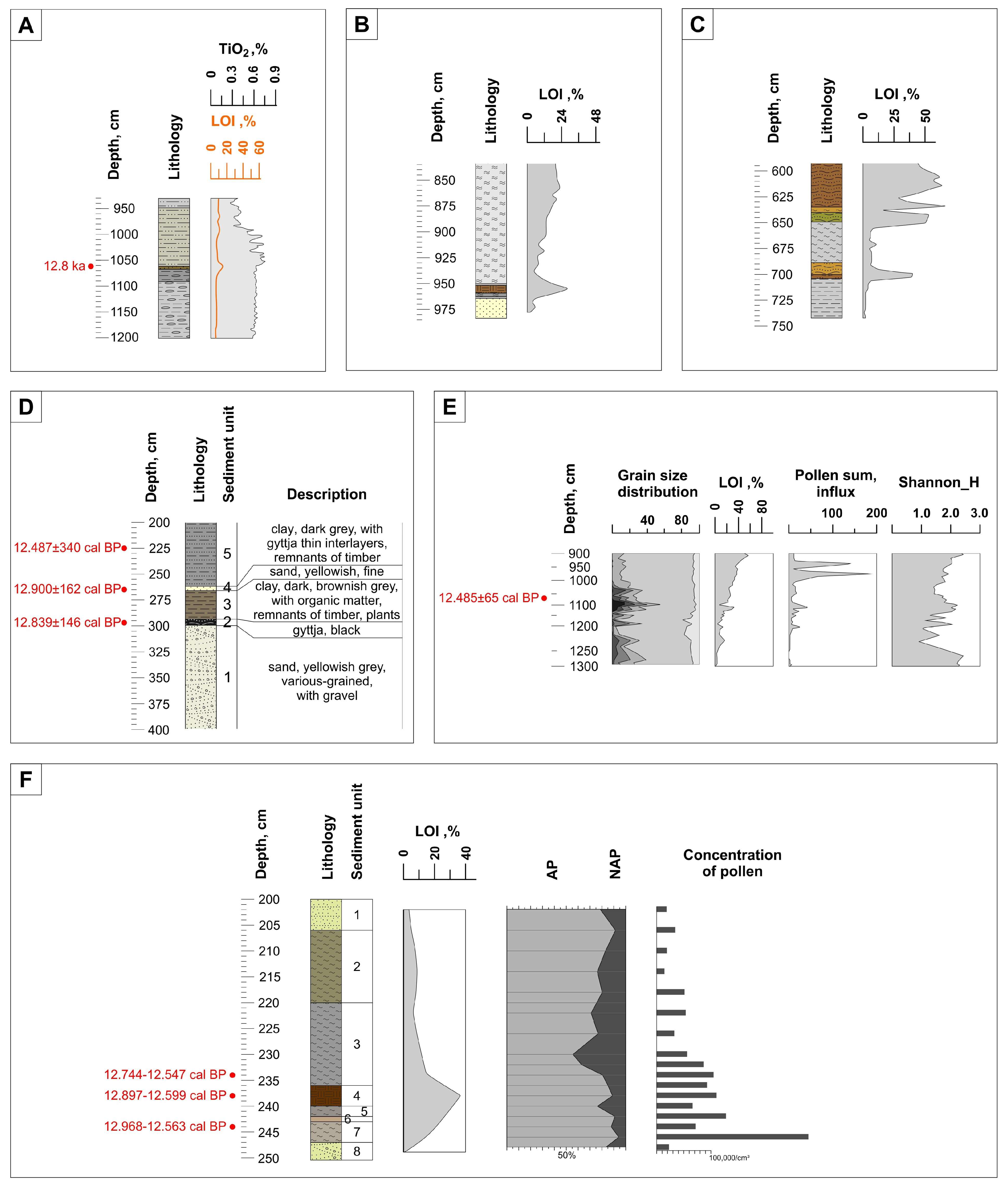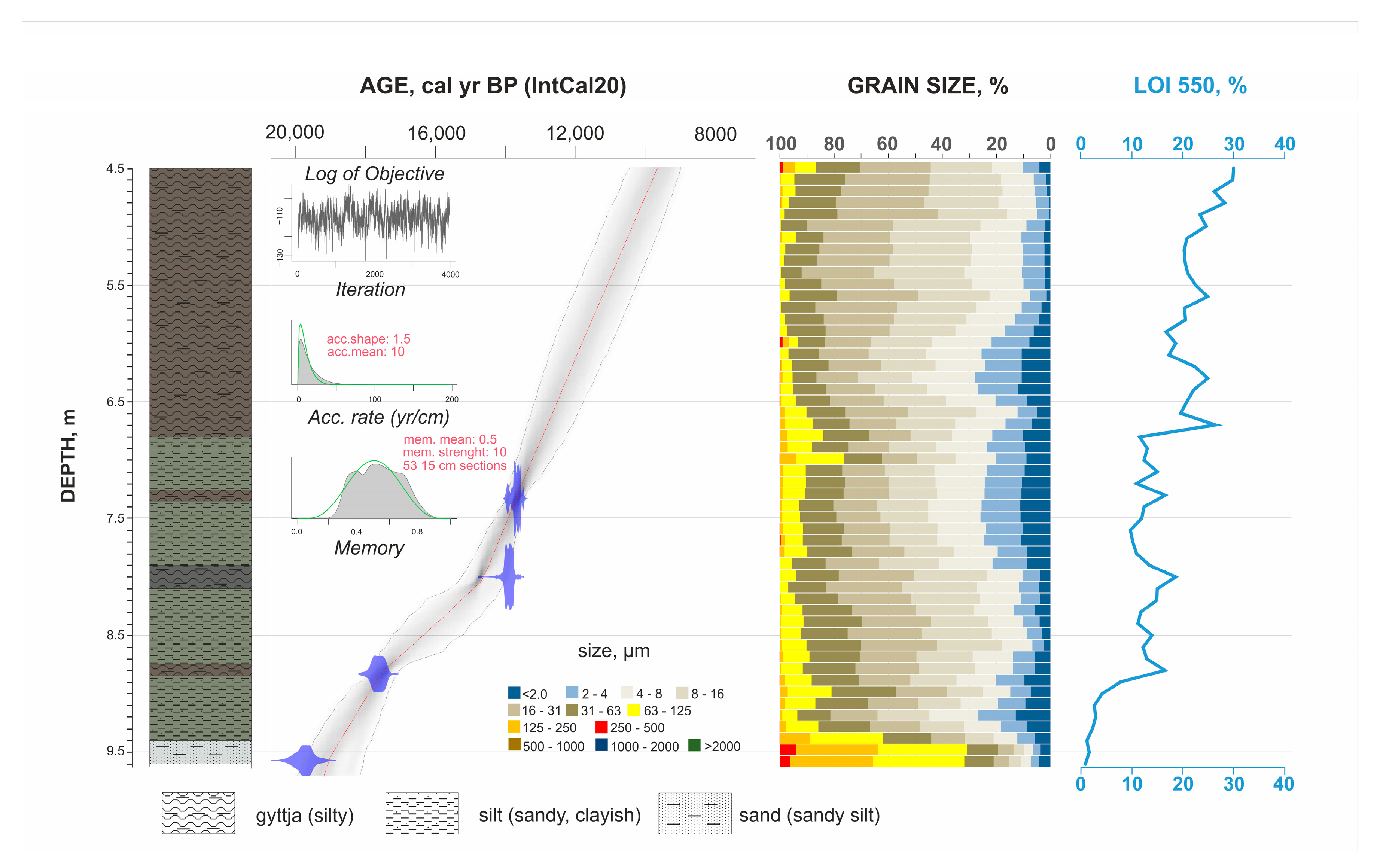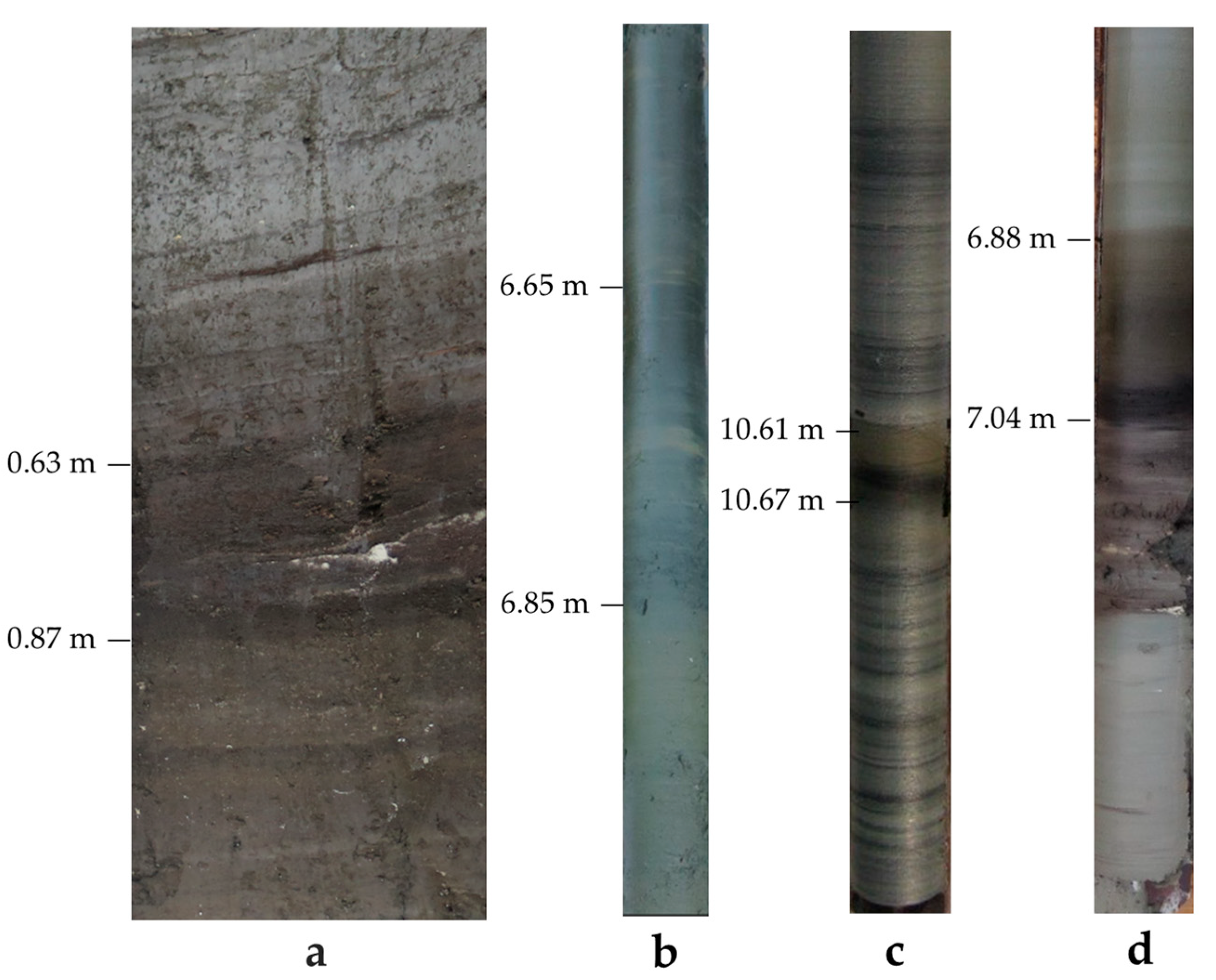Allerød–Younger Dryas Boundary (12.9–12.8 ka) as a “New” Geochronological Marker in Late Glacial Sediments of the Eastern Baltic Region
Abstract
1. Introduction
2. Materials and Methods
2.1. Fieldwork and Sampling
2.2. Geochronological Analysis
2.3. Lithological Analysis (Grain Size and Loss on Ignition)
3. Results
3.1. Geochronology
3.2. Lithology
4. Discussion
| No. | Location | Coordinates, m a.s.l. | Parameters | Available Dating | References |
|---|---|---|---|---|---|
| 1 | Kulikovo | N54°56′12.9″; E20°21′31″; 2 | Visual change in lithostratigraphy, coarse material interlayer, granulometry, LOI, presence of organics, and pollen concentration | AMS 14C, modelled age | This publication |
| 2 | Sambian | N54°50′00″ E20°30′00″; 13 | Granulometry and LOI | AMS 14C, modelled age | This publication |
| 3 | Kamyshovoe | N54°22′36.1″; E22°42′47″; 192 | Visual change in lithostratigraphy, LOI, and geochemistry (TiO2) | AMS 14C, modelled age | [30,31] |
| 4 | Chistoe | N54°23′22.5″; E22°43′47″; 201.7 | Visual change in lithostratigraphy and LOI | Biostratigraphy | [32] |
| 5 | Protochnoe | N54°24′18.7″; E22°36′43.4″; 153 | Visual change in lithostratigraphy and LOI | Biostratigraphy | [32] |
| 6 | Kozmin Las | N52°4′51.3″; E18°40′03″; 97.5 | Visual change in lithostratigraphy, LOI, presence of organics (wood), and pollen concentration | AMS 14C | [28] |
| 7 | Lopaičiai | N55°44′37.47″; E22°11′34.28″; 178.7 | Visual change in lithostratigraphy, coarse material interlayer, presence of organics (wood and other plants), and pollen concentration | AMS 14C | [29] |
| 8 | Dukstelis | N54°50′10″; E25°09′59″; 156 | Granulometry, LOI, pollen concentration, and Shannon Diversity Index | AMS 14C | [33] |
| 9 | Serteya Mire | N 55°37′53″; E31°32′28″; 152.5 | Visual change in lithostratigraphy, granulometry, LOI, geochemistry (erosion rate, Ca/Fe), and presence of organics | AMS 14C | [34] |
| 10 | Myantyulampi | N64°54′51″; E30°54′52.8″; 12 | Visual change in lithostratigraphy, coarse material interlayer, and presence of organics (burnt wood) | 14C | [35] |
| 11 | Polevskoye | N62°18′43″; E35°16′49″; 54.7 | Visual change in lithostratigraphy, coarse material interlayer, and presence of organics | Biostratigraphy | [36] |
| 12 | Keratskoe | N62°19′39.9″; E35°15′42.2″; 54.6 | Visual change in lithostratigraphy, coarse material interlayer, and presence of organics | Biostratigraphy | [36] |

5. Conclusions
Author Contributions
Funding
Data Availability Statement
Acknowledgments
Conflicts of Interest
Abbreviations
| YD | Younger Dryas |
| Al-YDB | Allerød—Younger Dryas boundary |
| ADM | Age Depth Model |
| LOI | Loss-on-ignition |
| AP | Arboreal pollen |
| NAP | Non-arboreal pollen |
References
- Naughton, F.; Sanchez-Goni, M.; Landais, A.; Rodrigues, T.; Vazguez Riveiros, N.; Toucanne, S. The Younger Dryas Stadial. In European Glacial Landscapes. The Last Deglaciation; Palacios, D., Hughes, P., Garcia-Ruiz, J., Andres, N., Eds.; Elsevier: Amsterdam, The Netherlands, 2023; pp. 51–59. [Google Scholar]
- McManus, J.F.; Francois, R.; Gherardi, J.-M.; Keigwin, L.D.; Brown-Leger, S. Collapse and rapid resumption of Atlantic meridional circulation linked to deglacial climate changes. Nature 2004, 428, 834–837. [Google Scholar] [CrossRef] [PubMed]
- Firestone, R.B.; West, A.; Kennett, J.P.; Becker, L.; Bunch, T.E.; Revay, Z.S.; Schultz, P.H.; Belgya, T.; Kennett, D.J.; Erlandson, J.M.; et al. Evidence for an extraterrestrial impact 12,900 years ago that contributed to the megafaunal extinctions and the Younger Dryas cooling. Proc. Natl. Acad. Sci. USA 2007, 104, 16016–16021. [Google Scholar] [CrossRef]
- Powell, J. Premature rejection in science: The case of the Younger Dryas Impact Hypothesis. Sci. Prog. 2022, 105, 1–43. [Google Scholar] [CrossRef] [PubMed]
- Holliday, V.T.; Daulton, T.L.; Bartlein, P.J.; Boslough, M.B.; Breslawski, R.P.; Fisher, A.E.; Jorgeson, I.A.; Scott, A.C.; Koeberl, C.; Marlon, J.; et al. Comprehensive refutation of the Younger Dryas Impact Hypothesis (YDIH). Earth Sci. Rev. 2023, 247, 104502. [Google Scholar] [CrossRef]
- Sweatman, M.; Powell, J.; West, A. Rejection of Holliday et al.’s alleged refutation of the Younger Dryas impact hypothesis. Earth-Sci. Rev. 2024, 258, 104960. [Google Scholar] [CrossRef]
- Veski, S.; Seppä, H.; Stančikaitė, M.; Zernitskaya, V.; Reitalu, T.; Gryguc, G.; Heinsalu, A.; Stivrins, N.; Amon, L.; Vassiljev, J.; et al. Quantitative summer and winter temperature reconstructions from pollen and chironomid data between 15 and 8 ka BP in the Baltic–Belarus area. Quat. Int. 2015, 388, 4–11. [Google Scholar] [CrossRef]
- Schenk, F.; Bennike, O.; Valiranta, M.; Avery, R.; Bjorck, S.; Wohlfarth, B. Floral evidence for high summer temperatures in southern Scandinavia during 15—11 cal ka BP. Quat. Sci. Rev. 2020, 233, 106243. [Google Scholar] [CrossRef]
- Muller, D.; Tjallingii, R.; Płociennik, M.; Luoto, T.P.; Kotrys, B.; Plessen, B.; Ramisch, A.; Schwab, M.J.; Błaszkiewicz, M.; Słowinski, M.; et al. Newinsights into lake responses to rapid climate change: The Younger Dryas in Lake Gosciaz, central Poland. Boreas 2021, 50, 535–555. [Google Scholar] [CrossRef]
- Kupryjanowicz, M. Postglacial development of vegetation in the vicinity of the Wigry Lake. Geochronometria 2007, 27, 53–66. [Google Scholar] [CrossRef]
- Stančikaitė, M.; Šeirienė, V.; Kisielienė, D.; Martma, T.; Gryguc, G.; Zinkutė, R.; Mažeika, J.; Šinkūnas, P. Lateglacial and early Holocene environmental dynamics in northern Lithuania: A multi-proxy record from Ginkūnai Lake. Quat. Int. 2015, 357, 44–57. [Google Scholar] [CrossRef]
- Kaiser, K.; Hilgers, A.; Schlaak, N.; Jankowski, M.; Kuhn, P.; Bussemer, S.; Przegietka, K. Palaeopedological marker horizons in northern central Europe: Characteristics of Lateglacial Usselo and Finow soils. Boreas 2009, 38, 591–609. [Google Scholar] [CrossRef]
- Wolbach, W.; Ballard, J.; Mayewski, P.; Kurbatov, A.; Bunch, T.; Le Compte, M.; Adedeji, V.; Israde-Alcántara, I.; Firestone, R.; Mahaney, W.; et al. Extraordinary biomass-burning episode and impact winter triggered by the Younger Dryas cosmic impact <12,800 years ago. 2. Lake, marine, and terrestrial sediments. J. Geol. 2018, 126, 185–205. [Google Scholar]
- Gałka, M.; Tobolski, K.; Bubak, I. Late Glacial and Early Holocene lake level fluctuations in NE Poland tracked by macro-fossil, pollen and diatom records. Quat. Int. 2015, 388, 23–38. [Google Scholar] [CrossRef]
- Muschitiello, F.; Lea, J.M.; Greenwood, S.L.; Nick, F.M.; Brunnberg, L.; Macleod, A.; Wohlfarth, B. Timing of the first drainage of the Baltic Ice Lake synchronous with the onset of Greenland Stadial 1. Boreas 2015, 45, 322–334. [Google Scholar] [CrossRef]
- Haynes, C.V. Younger Dryas “black mats” and the Rancholabrean termination in North America. Proc. Natl. Acad. Sci. USA 2008, 105, 6520–6525. [Google Scholar] [CrossRef]
- Druzhinina, O.; Rudinskaya, A.; Filippova, K.; Lazukova, L.; Lavrova, N.; Zharov, A.; Skhodnov, I.; Burko, A.; van den Berghe, K. The Bølling–Allerød Transition in the Eastern Baltic: Environmental Responses to Climate Change. Biology 2023, 12, 821. [Google Scholar] [CrossRef]
- Golyeva, A.A.; Druzhinina, O.A. Microbiomorphic analysis in the study of the late glacial natural environment: Preliminary results of the study of the Kulikovo section (Sambian Peninsula, Kaliningrad region). Bull. Russ. Acad. Sci. Geogr. Ser. 2024, 88, 77–89. (In Russian) [Google Scholar]
- Rudinskaya, A.I.; Druzhinina, O.A.; Filippova, K.G.; Lazukova, L.I. New data on Late Glacial diatoms of the SE Baltic region based on the results of studying the Kulikovo section. Limnol. Freshw. Biol. 2024, 4, 612–617. [Google Scholar] [CrossRef]
- Geographical Atlas of the Kaliningrad Region; CNIT: Kaliningrad, Russia, 2002; 302p. (In Russian)
- Reimer, P.; Austin, W.E.N.; Bard, E.; Bayliss, A.; Blackwell, P.G.; Ramsey, C.B.; Butzin, M.; Cheng, H.; Edwards, R.L.; Friedrich, M.; et al. The IntCal20 Northern Hemisphere radiocarbon age calibration curve (0-55 cal kBP). Radiocarbon 2020, 62, 725–757. [Google Scholar] [CrossRef]
- Blaauw, M.; Christen, J.A. Flexible paleoclimate age-depth models using an autoregressive gamma process. Bayesian Anal. 2011, 6, 457–474. [Google Scholar] [CrossRef]
- Özer, M.; Orhan, M.; Isik, N.S. Effect of Particle Optical Properties on Size Distribution of Soils Obtained by Laser Diffraction. Environ. Eng. Geosci. 2010, 16, 163–173. [Google Scholar] [CrossRef]
- Heiri, O.; Lotter, A.F.; Lemcke, G. Loss on ignition as a method for estimating organic and carbonate content in sediments: Reproducibility and comparability of results. J. Paleolimnol. 2001, 25, 101–110. [Google Scholar] [CrossRef]
- Subetto, D.A. Donnyye otlozheniya ozer: Paleolimnologicheskiye rekonstruktsii [Lake sediments: Palaeolimnological reconstructions]; RGPU im. A. I. Gertsena Pub.: Saint-Petersburg, Russia, 2009; 348p. (In Russian) [Google Scholar]
- Kisieliene, D.; Stancikaite, M.; Merkevicius, A.; Namickiene, R. Vegetation responses to climatic changes during the late glacial according to palaeobotanical data in western Lithuania: Preliminary results. Pol. Geol. Inst. Spec. Pap. 2005, 16, 45–52. [Google Scholar]
- Pino, M.; Abarzúa, A.; Astorga, G.; Martel-Cea, A.; Cossio-Montecinos, N.; Navarro, R.X.; Paz Lira, M.; Labarca, R.; Le Compte, M.A.; Adedeji, V.; et al. Sedimentary record from Patagonia, southern Chile supports cosmic-impact triggering of biomass burning, climate change, and megafaunal extinctions at 12.8 ka. Nature 2019, 9, 4413. [Google Scholar] [CrossRef]
- Dzieduszyńska, D.; Kittel, P.; Petera-Zganiacz, J.; Brooks, S.; Korzeń, K.; Krapiec, M.; Pawłowski, D.; Płaza, D.; Płóciennik, M.; Stachowicz-Rybka, R.; et al. Environmental influence on forest development and decline in the Warta River valley (Central Poland) during the Late Weichselian. Quat. Int. 2014, 324, 99–114. [Google Scholar] [CrossRef]
- Kabailienė, M.; Vaikutienė, G.; Macijauskaitė, L.; Rudnickaitė, E.; Guobytė, R.; Kisielienė, D.; Gryguc, G.; Mažeika, J.; Motuza, G.; Šinkūnas, P. Lateglacial and Holocene environmental history in the area of Samogitian Upland (NW Lithuania). Baltica 2015, 28, 163–178. [Google Scholar] [CrossRef]
- Druzhinina, O.; Kublitskiy, Y.; Stancikaite, M.; Nazarova, L.; Syrykh, L.; Gedminiene, L.; Uogintas, D.; Skipityte, R.; Arslanov, K.; Vaikutiene, G.; et al. The Late Pleistocene–Early Holocene palaeoenvironmental evolution in the SE Baltic region: A new approach based on chironomid, geochemical and isotopic data from Kamyshovoye Lake. Boreas 2020, 49, 544–561. [Google Scholar] [CrossRef]
- Kublitskiy, Y.; Kulkova, M.; Druzhinina, O.; Subetto, D.; Stancikaite, M.; Gedminiene, L.; Arslanov, K. Geochemical approach to the reconstruction of sedimentation processes in Kamyshovoye lake (SE baltic, Russia) during the Lateglacial and Holocene. Minerals 2020, 10, 764. [Google Scholar] [CrossRef]
- Kublitsky, Y. The Dynamic of Nature Condition of SE Part of Baltic Region During Late Neopleistocene and Holocene. Ph.D. Thesis, Saint-Petersburg University, Saint-Petersburg, Russia, 2016; 150p. (In Russian). [Google Scholar]
- Gedminiene, L.; Spiridonov, A.; Stancikaite, M.; Skuratovic, Z.; Vaikutiene, G.; Daumantas, L.; Salonen, S. Temporal and spatial climate changes in the mid-Baltic region in the Late Glacial and the Holocene: Pollen-based reconstructions. Catena 2025, 252, 108851. [Google Scholar] [CrossRef]
- Kittel, P.; Mazurkevich, A.; Gauthier, E.; Kazakov, E.; Kublitskiy, Y.; Rzodkiewicz, M.; Mroczkowska, A.; Okupny, D.; Słowiński, M.; Szmańda, J.; et al. A great history in a small wetland: Human-environment relationships on the East European Plain in the last 13 thousand years. In Proceedings of the IAL IPA: Lakes, Memories of the Landscape, Bariloche, Argentina, 27 November–1 December 2022. [Google Scholar] [CrossRef]
- Kuznetsov, D.; Subetto, D. Stratiraphy of Lake Sediments of the Karelian Istmus; GEOS: Moscow, Russia, 2019; 120p. (In Russian) [Google Scholar]
- Ryazantsev, P.; Subetto, D. Turbidit sediments investigation in Onego Ice lake. In Paleolimnology of Lake Onego: From the Onego Ice lake to the Present State; Subetto, D., Ed.; Kar NC RAN: Petrozavodsk, Russia, 2022; pp. 92–106. (In Russian) [Google Scholar]
- Zavala, C.; Arcuri, M. Intrabasinal and extrabasinal turbidites: Origin and distinctive characteristics. Sediment. Geol. 2016, 337, 36–54. [Google Scholar] [CrossRef]
- Pszonka, J.; Zecova, K.; Wendorff, M. Oligocene turbidite fans of the Dukla Basin: New age data from the calcareous nannofossils and paleoenvironmental conditions (Cergowa beds, Polish–Slovakian borderland). Geol. Carpathica 2019, 70, 311–324. [Google Scholar] [CrossRef]
- Turner, A.J.; Woodward, J.; Dunning, S.; Shine, A.J.; Stokes, C.R.; Cofaigh, C. Geophysical surveys of the sediments of Loch Ness, Scotland: Implications for the deglaciation of the Moray Firth Ice Stream, British-Irish Ice Sheet. J. Quat. Sci. 2012, 27, 221–232. [Google Scholar] [CrossRef]




| Depth, cm | Sample | Material | Age, 14C | Age, cal yr BP (68.2% Probability) |
|---|---|---|---|---|
| 45 | LuS-18463 | macroremains (wood) | 10,940 ± 60 | 12,900–12,760 |
| 106 | LuS-18462 | macroremains (wood) | 11,060 ± 60 | 13,075–12,920 |
| 163 | LuS-18461 | macroremains (wood) | 11,790 ± 60 | 13,755–13,525 |
| 186 | LuS-18460 | macroremains (wood) | 11,980 ± 80 | 14,020–13,785 |
| 192 | LuS-17811 | sediment (gyttja) | 12,200 ± 60 | 14,185–14,040 |
| Depth, cm | Sample | Material | Age, 14C | Age, cal yr BP (68.2% Probability) |
|---|---|---|---|---|
| 220 | LU-11433 * | peat | 6670 ± 100 | 7620–7430 |
| 270 | LU-11432 * | peat | 6940 ± 90 | 7920–7680 |
| 349 | LuS-19369 | peat | 7425 ± 45 | 8325–8185 |
| 734 | LuS-19367 | sediment (silty gyttja) | 11,880 ± 70 | 13,800–13,605 |
| 801 | LuS-19370 | sediment (silty gyttja) | 12,060 ± 70 | 14,040–13,805 |
| 884 | LuS-19368 | sediment (silty gyttja) | 14,480 ± 80 | 17,805–17,480 |
| 958 | LuS-19371 | sediment (silt) | 16,360 ± 160 | 19,930–19,540 |
| Depth, cm | Lithostratigraphy |
|---|---|
| 0–14 | Clay, grey, and dense |
| 14–63 | Gittja, clayish, grey, and light brown, with sparse organic matter |
| 63–87 | Gittja, peaty, and dark brown, with organic matter and a thin sandy interlayer |
| 87–158 | Gittja, clayish, dark grey, and brown, with organic matter and shells |
| 158–171 | Gittja and dark grey, with organic matter and shells |
| 171–181 | Gittja, clayish, and dark grey, with sparse organic matter and shells |
| 181–186 | Gittja, peaty, and dark brown |
| 186–192 | Gittja, clayish, and brown, with organic matter |
| Depth, m | Lithostratigraphy |
|---|---|
| 4.5–6.8 | Gyttja; silty; dark grey, brownish, and olive |
| 6.8–7.9 | Silt, sandy, clayish, and laminated; grey and olive; with an interlayer of silty gittja at 7.3 m |
| 7.9–8.1 | Gyttja, silty, and dark grey |
| 8.1–9.4 | Silt, sandy, clayish, and laminated; grey and olive; with an interlayer of silty gittja at 8.8 m |
| 9.4–9.6 | Sand; sandy silt |
Disclaimer/Publisher’s Note: The statements, opinions and data contained in all publications are solely those of the individual author(s) and contributor(s) and not of MDPI and/or the editor(s). MDPI and/or the editor(s) disclaim responsibility for any injury to people or property resulting from any ideas, methods, instructions or products referred to in the content. |
© 2025 by the authors. Licensee MDPI, Basel, Switzerland. This article is an open access article distributed under the terms and conditions of the Creative Commons Attribution (CC BY) license (https://creativecommons.org/licenses/by/4.0/).
Share and Cite
Druzhinina, O.; Skhodnov, I.; van den Berghe, K.; Filippova, K. Allerød–Younger Dryas Boundary (12.9–12.8 ka) as a “New” Geochronological Marker in Late Glacial Sediments of the Eastern Baltic Region. Quaternary 2025, 8, 28. https://doi.org/10.3390/quat8020028
Druzhinina O, Skhodnov I, van den Berghe K, Filippova K. Allerød–Younger Dryas Boundary (12.9–12.8 ka) as a “New” Geochronological Marker in Late Glacial Sediments of the Eastern Baltic Region. Quaternary. 2025; 8(2):28. https://doi.org/10.3390/quat8020028
Chicago/Turabian StyleDruzhinina, Olga, Ivan Skhodnov, Kasper van den Berghe, and Ksenia Filippova. 2025. "Allerød–Younger Dryas Boundary (12.9–12.8 ka) as a “New” Geochronological Marker in Late Glacial Sediments of the Eastern Baltic Region" Quaternary 8, no. 2: 28. https://doi.org/10.3390/quat8020028
APA StyleDruzhinina, O., Skhodnov, I., van den Berghe, K., & Filippova, K. (2025). Allerød–Younger Dryas Boundary (12.9–12.8 ka) as a “New” Geochronological Marker in Late Glacial Sediments of the Eastern Baltic Region. Quaternary, 8(2), 28. https://doi.org/10.3390/quat8020028






